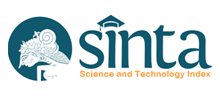Keywords
social media, communication, disaster, hydrometeorology, agriculture
Document Type
Article
Abstract
Social media as a means of communication plays a role in building a new paradigm of disaster. One of the social media users for hydrometeorological disaster communication is a shallot farmer in Parangtritis Village, Kretek Subdistrict, Bantul District, Yogyakarta Special Region. This study aims to determine the role of social media as a means of communication for hydrometeorological disasters in shallot farming activities. The design of this research is descriptive quantitative research. The research was carried out from April to October 2021 by taking the location of shallot farmers in Parangtritis Village, Kretek Subdistrict, Bantul District, Yogyakarta Special Region. The research sample was determined by a quota of 50 respondents. Research data were collected through observation, interviews, and documentation. The data that has been collected is then processed and analyzed descriptively. The results of this study show that: (1) The respondents' ownership of gadgets is 84%. Of all respondents who have gadgets, 71.4% of respondents have an internet connection. (2) All respondents stated that ownership of gadgets and internet connection is useful in hydrometeorological disaster information. (3) All respondents who have gadgets and internet connections have facebook and whatsapp social media accounts. (4) The role of ownership of social media accounts is as a means of exchanging information on hydrometeorological disasters, namely information related to shallot farming activities (seedlings, soil processing, fertilizers, pest eradication, harvesting, etc.) and information on the threat of hydrometeorological disasters on shallot farming, such as floods and extreme weather. The existence of social media is able to have a positive impact on shallot farmers, especially in adapting to existing weather conditions with strategies to change crop variations, change cropping patterns, change planting periods, and change irrigation systems, thereby helping harvest success.
First Page
47
Last Page
62
Page Range
47-62
Issue
1
Volume
52
Digital Object Identifier (DOI)
10.21831/informasi.v52i1.50115
Source
50115
Recommended Citation
Khotimah, N., Sumunar, D. R., Purwantara, S., Prabintoro, N. S., Ibrahim, M. H., & Nayan, N. (2022). The role of social media as a communication facility for hydrometeorological disasters in shallot farming activities. Informasi, 52(1), 47-62. https://doi.org/10.21831/informasi.v52i1.50115
References
Akbar, S. (2021). Media communications in supporting dissemination information on the countermeasure of covid-19 pandemic. Majalah Ilmiah Semi Populer Komunikasi Massa, 2(1), 73-82. ISSN: 2721-6306.
Arikunto, S. (2013). Prosedur Penelitian: Suatu Pendekatan Praktek. Rineka Cipta.
Asteria, D. (2016). Optimalisasi Komunikasi Bencana di Media Massa Sebagai Pendukung Manajemen Bencana. Jurnal Komunikasi (Jurnal Ikatan Sarjana Komunikasi Indonesia), 1(1), 1-11. https://doi.org/10.25008/jkiski.v1i1.30.
Azizah, M., Apriadi, R. K., Januarti, R. T., Winugroho, T., Yulianto, S., Kurniawan, W., & Widana, I. D. K. K. (2022). Kajian Risiko Bencana Berdasarkan Jumlah Kejadian dan Dampak Bencana di Indonesia Periode Tahun 2010-2020. PENDIPA Journal of Science Education, 6(1), 35-40. https://doi.org/10.33369/pendipa.6.1.35-40.
BPS - Statistics of Bantul Regency. (2021). Kretek Subdistrict in Fiqures 2021. Katalog: 1102001.3402030. https://bantulkab.bps.go.id
Fahriyani, S., Harmaningsih, D., Yunarti, S. (2020). Penggunaan Media Sosial Twitter Untuk Mitigasi Bencana di Indonesia. Jurnal IKRA-ITH Humaniora, 4(2), 56-65.
Gelgel, N.M.R.A (2020). Media Sosial dan Literasi Kebencanaan di Bali. Interaksi: Jurnal Ilmu Komunikasi, 9(1), 19-30. ISSN 2310-6051 (Print), ISSN 2548-4907 (online). http://dx.doi.org/10.14710/interaksi.9.1.19-30.
Hermon, Dedi. (2012). Mitigasi Bencana Hidrometeorologi. UNP Press.
Khotimah, N. (2019). Pranata Mangsa and the sustainability of agricultural land resources management in Imogiri sub-district of Bantul regency. IOP Conference Series: Earth and Environmental Science, Volume 338, Published online: 25 November 2019. ISSN 1755-1315. https://iopscience.iop.org/article/10.1088/1755-1315/338/1/012029.
Law of the Republic of Indonesia Number 24 of 2007 concerning Disaster Management.
Mosher A.T. (1987). Menggerakkan dan Membangun Pertanian: Syarat-Syarat Pokok Pembangunan dan Modernisasi. Jakarta: CV Yasaguna.
Nugroho, S.P., Sulistyorini, D. (2020). Komunikasi Bencana: Membedah Relasi BNPB dengan Media. Jakarta: Pusat Data, Informasi dan Hubungan Masyarakat Badan Nasional Penanggulangan Bencana, Graha BNPB Jl. Pramuka Kav. 38, ISBN: 978-602-73947-4-2.
Permana, S.A. (2015). Manajemen Sistem Informasi Kebencanaan: Studi Kasus Jogja Tanggap Cepat Dalam Mengelola Informasi Bencana Erupsi Merapi. Yogyakarta: Seminar Nasional Universitas PGRI Yogyakarta, ISBN 978-602-73690-3-0.
Petani Kaltim Harus Mampu Kuasai TI. (2014, July 5). Accessed https://www.kaltimprov.go.id/berita/petani-kaltim-harus-mampu-kuasai-ti
Putra, I.G.N. (2006). Media dan Agenda-Agenda Pemberdayaan Pasca Bencana: Memaksimalkan Fungsi Watchdog. Makalah Seminar Media, Solidaritas Sosial, dan Proses Rekonstruksi Pasca Bencana, Jurusan Ilmu Komunikasi FISIPOL UGM & Yayasan SET, August 9, 2006.
Rasyid. (2018). Komunikasi dan Media dalam Penyebaran Informasi Terhadap Khalayak. PT. Rosdakarya.
Shahzad, U., & Riphah. (2012). Global Warming-Causes, Effects and Solution's Trials. Journal of Engineering Sciences, 40(4), 1233-1254. DOI: 10.21608/jesaun.2012.114490.
Sukardi. (2008). Metodologi Penelitian Pendidikan: Kompetensi dan Praktiknya. Jakarta: PT Bumi Aksara.
Tingsanchali, T. (2012). Urban Flood Disaster Management. Procedia Engineering, 32, 25-37. doi:10.1016/j.proeng.2012.01.1233

